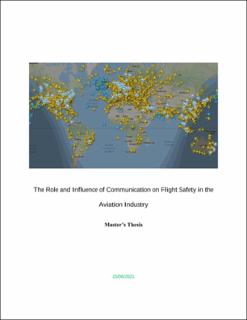| dc.description.abstract | Flight safety in the aviation industry is a number one priority all over the world. It is provided by numerous stakeholders and highly depends on many aspects, starting from communication, technical maintenance, Air Traffic controllers, and pilots’ proficiency, and ending up by security checks at the airports’ terminals. Simultaneously, piloting proficiency and communication stand out of the list and play an equally important role in safe flights’ operations. Though overall aviation is considered to be safe transportation, yet there is always room for improvement. Based on qualitative in-depth interviews this research identified the key role of communication in flight safety and determined language and cultural issues as the main aspects affecting communication in the cockpit. The conclusion suggests the need of improving English language proficiency, especially in: China, Brazil, Japan; the necessity of using aviation phraseology in native English-speaking countries of the Northern American continent and Australia. Along with language issues, culture-related aspects such as Power Distance and Individualism vs. Collectivism need special attention.
Key words: Aviation, Safety, Communication, Language, Cultural Aspects, Crew Resource Management (CRM) | |
